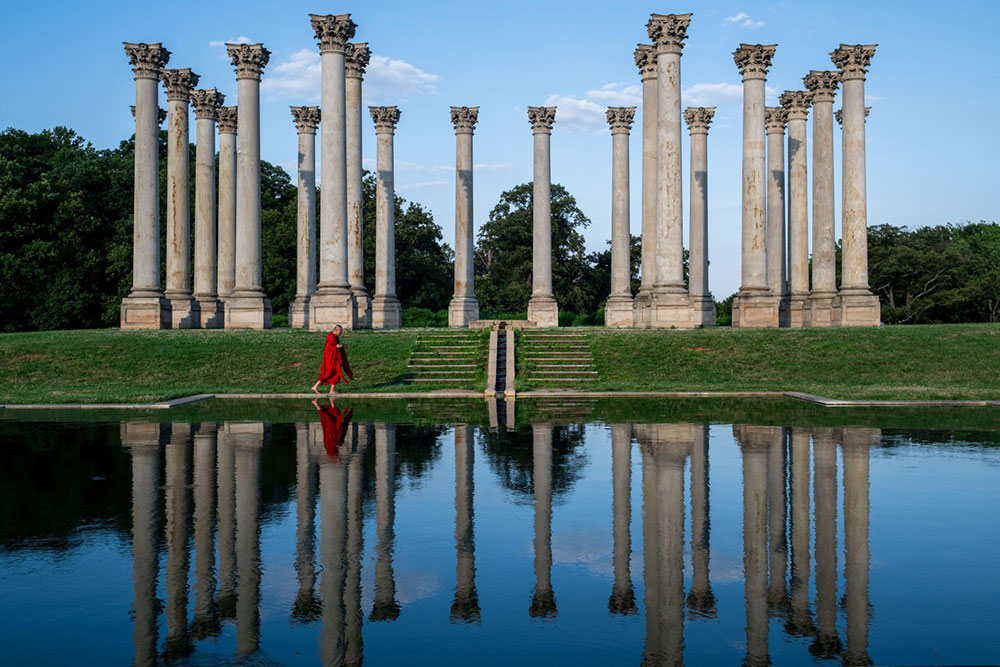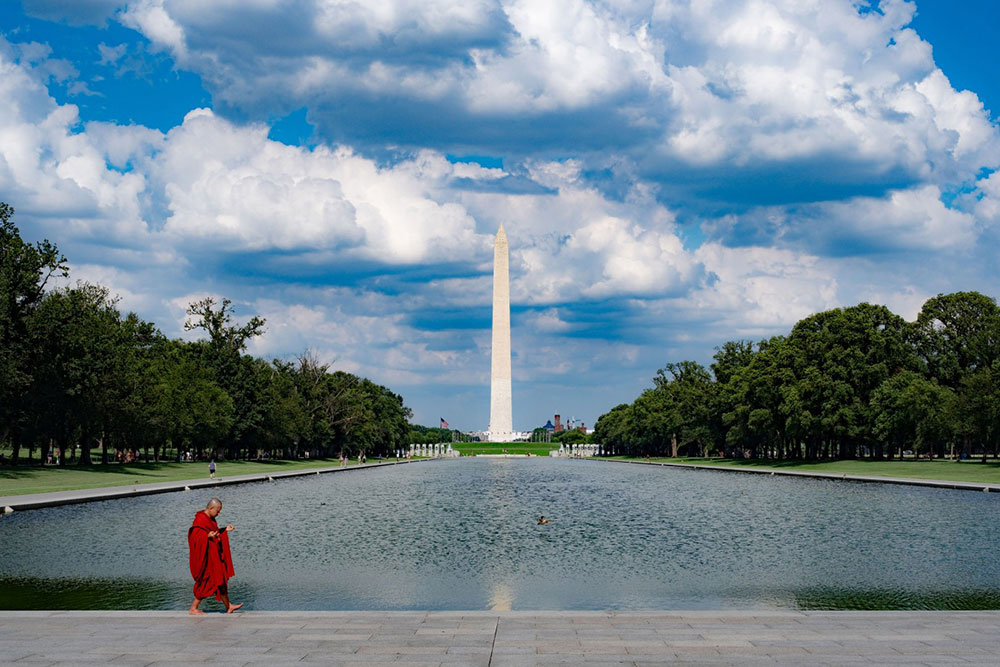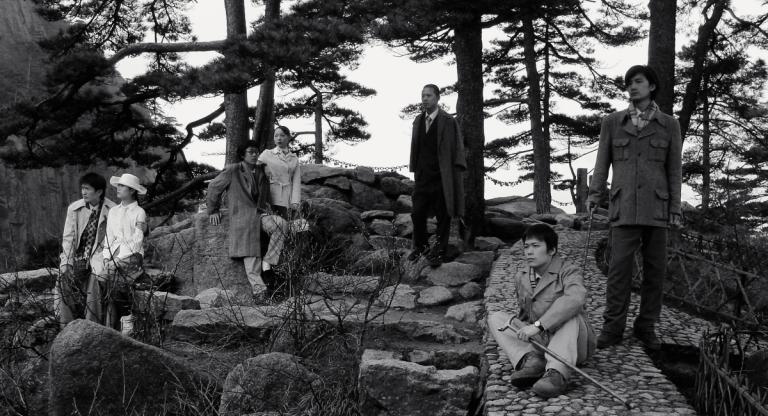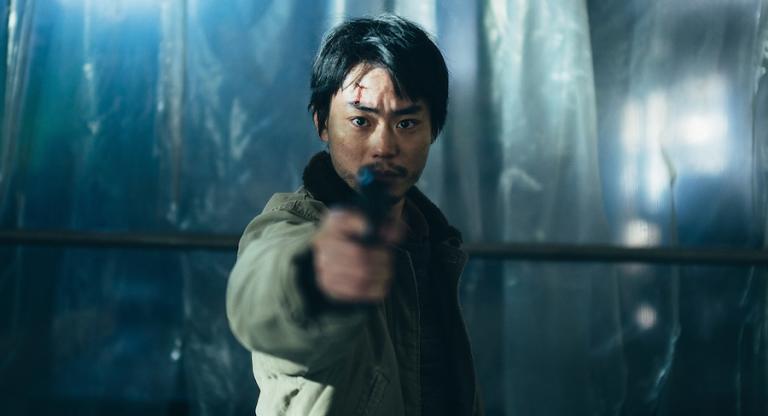Tsai Ming-liang should need little introduction as the director of Rebels of the Neon God (1992), Vive l’Amour (1994), Goodbye, Dragon Inn (2003), and Stray Dogs (2013), and a progenitor of an entire contemplative school of cinema on par with fellow Taiwanese auteur Hou Hsiao-hsien. He can plumb depths of pathos in all of our overwhelming desires and vulnerability, but twinned by a comic sense of the hapless absurdity of being human. One Tsai project that gets less attention than his fiction features is his Walker series, starring his acteur fétiche Lee Kang-sheng as a red-robed monk traversing the globe at a hallucinogenically gradual pace—homemade slow-motion in Hong Kong, Marseille, Tokyo, Paris, and now Washington, D.C.
The latest installment, Abiding Nowhere (2024), screened last week in D.C. at Smithsonian’s National Museum of Asian Art, which commissioned the work for its centennial with support from Taiwan’s Ministry of Culture. Hence the setting: Lee slowly traverses the D.C. streets, Union Station, the National Museum of Asian Art, and passes by the Washington Monument as well as a pond in Great Falls Park. A separate strand of scenes stars Anong Houngheangsy (who also assists Tsai with production) carefully preparing noodles, as in Tsai’s last feature, Days (2020). In Lee’s hands (or rather feet) the monk’s undistracted progress is not only entrancing but can also be amusing in the inevitable juxtaposition with tourists and other passersby.
The origins of the Walker series are mystical and mundane in a way that feels suited to Tsai. Lee’s figure in a landscape is inspired by Xuanzang, a Chinese monk who traveled thousands of miles during the Tang Dynasty to retrieve scriptures from India (657 items packed in 520 cases in all). But the films technically began with a carte blanche ad commission from a Taiwanese mobile phone company. When the company went under, Tsai released the short he’d made as Walker. Nine shorts followed; Tsai told Tom Vick, the museum’s curator of film, that he still wanted to go to New York, Chicago, and Monument Valley, where Ford shot his Westerns. For the D.C. production, Tsai moved quickly and efficiently, working with natural light and using his crew from Taiwan (including DP Chang Jhong-yuan) and help from D.C. hires such as a local line producer. (Fun fact: All the calligraphy in the Walker series was done by Lee.)
Abiding Nowhere will next screen at CPH:DOX in Copenhagen and at the Hong Kong Film Festival, with more locations likely to be announced. (Tsai’s previous Walker entry screened in New York in Prismatic Ground, and unofficial versions of the first Walker can be found online.) Clad in black and punctuating his answers with delighted chuckles, Tsai fielded questions about different facets of his career, filmmaking, and making Abiding Nowhere while in Berlin, where the film had its world premiere. “I myself feel out of time!” he said at one point, comparing himself to the walker in the series. “But by seeing my speed, I want you to think about your speed.”

On the origin of the Walker series:
It began with a theatrical production, a play, more than 10 years ago [Only You, in 2011]. I was directing Lee Kang-sheng on the stage and I was really obsessed with the way he walked on the stage, this very slow way of walking. Only a small group of people saw this production, so I wanted to make a very pure film—just walking, nothing else. It's about Lee Kang-sheng walking in different corners of the world, so I wanted to make 10 Walker films in 10 years. Now I have made 10, and it seems to me that I can’t stop the series. So I will continue making them.
On the importance of showing on a big screen:
Because details matter. My films do not have storytelling content. They don't have performances. Actually, everything is natural. I want the audience to really pay attention to the changing of the light. So it has to be shown in a very good physical environment with very good sound. I actually thought that the screen at the Berlinale was not big enough. The importance of sound is equal to the importance of image. I just want to represent real feelings. So when we're working in the studio, I really pay a lot of attention to the sounds. I do not design sounds. I just enhance sounds.
On choosing Washington, D.C., locations for the latest Walker film:
For the pre-production, I did a location scout once or twice. I've never been to D.C. until last year [for my retrospective]. We all seem to be very familiar with Washington, D.C. because there have been so many American films about D.C. So I was looking at the landmarks but I was also looking at normal places. Eventually I still chose to have the Washington Monument because otherwise nobody would know that I was shooting in D.C. [chuckles] There’s an abandoned space that was transformed into an art space with a lot of graffiti. It used to be a church. It’s peculiar. I really enjoyed that space. I actually like the beginning and the end of this film very much. We start with the flowing river and then end with the pond and the floating bugs, and to me, that was almost religious. That's why I decided to have this religious Buddhist music for the credits.
On the meaning of the title Abiding Nowhere:
It's a quote from the Diamond Sutra, which is a very important scripture of Buddhism. It means that our hearts shouldn't be trapped. Your heart is actually very free, emancipated from worries.
On directing Lee Kang-sheng, his star since 1992, in the Walker series:
I do not direct him. I just told him where to walk. [chuckles] So the way I work with Lee Kang-sheng is actually kind of weird. Because we do not really communicate. I do not give him directions, and usually I would just leave him in some kind of state of mind and watch him develop. And amazingly, he always achieved what I wanted. When I work with other actors, I will give more directions. But when I work with Lee Kang-sheng, I just let him be. Usually he does not act too much. He’s just being real.
On shooting Abiding Nowhere:
We have to make decisions of where to shoot when we're doing location scouting. But when we’re there and filming with actors, I make decisions right on the spot. I work with my cinematographer, and we look for a good [camera] position.
On painting and cinema:
[chuckles] Yes, filming for me is painting now. For example, with my fixed camera, long takes, and long gazes, it creates a portrait or painting aspect. I actually call it portrait cinema. You can really focus on the face, but not on storytelling or plot. So if I am ever to make another feature film, it will be just like a portrait. That's something I've been thinking about.
On the beginnings of his career up to now:
Even from the very beginning I was a very serious filmmaker. [chuckles] Every time I got a chance to film something, I always believed that [it] was a gift given by God. I was actually working in TV and theater, and then I got a chance to film, and I decided that I wanted to make a difference. So now every time I make a film, that's always the thinking I have. And when I made Goodbye, Dragon Inn, which was invited to the competition in the Venice Film Festival, it was very different from my other films. In my previous films, I was actually telling a story with characters, but this one was actually about an object, which was the cinema, the theater itself.
On screening in a museum versus a cinema:
I do hope that I can present my Walker series in different spaces. I recently had an exhibition in Geneva, where they had an installation of five installments from the Walker series in one space. The five films were about five different cities, and I really enjoyed the atmosphere in that space because all the sounds and images were overlapping at the same time in one space. At the same time, I also want the Walker series to be shown and seen on big screens like in Berlin, Venice, or Cannes. I do believe that the series has a very unique existence: it's not a feature film, it's not a documentary film. I just want to show the world the possibilities of cinema.
On the influence of French films:
My favorite French cinema period was of course when Truffaut and Godard were making films, because they have a huge impact on me. Nowadays, I must tell you that I do not watch that many films. So I do not watch a lot of French cinema. But I have had the pleasure of working with all these wonderful French actors: Jeanne Moreau, Fanny Ardant, Jean-Pierre Leaud. It was a precious experience. Working with Denis Lavant was a wonderful experience as well in Journey to the West [2014].
On the state of funding:
The funding for my films came from different places. A lot of them came from institutions in, for example, Taiwan, or Vienna, and from museums. My films are not meeting the needs of the market, so of course I need different support from different sources to make sure that I have enough freedom to create. I have the feeling that our film industry right now is sort of trapped. What is the film industry about? You have a script and you make content for two hours and you need to meet the needs of the audience, and for example, when it comes to Netflix, it has certain demands and requirements. All these elements are trapping us. We do not have new development according to our artistic values for cinema. So that's why I started working with museums. I believe if we connect all the dots of the cinematic environments and the physical environments in museums, we can have a different kind of release.
On the audiences for his films:
For my first few films, all the audience questions for me were pretty much about the problems and situations in Asia. But slowly the focus was shifted to my images. Of course audiences will have different ways of perceptions and as an author, I cannot control them. My work is not about giving you information. There is no story. It's like a portrait painting or a landscape, and I'm just giving you the freedom to proceed and have your own interpretations. Because seeing my films, audiences have to be quiet, and their ideas start to emerge. These ideas are usually not there because they're not relaxed. But because of my films, they start to relax, so they enter a kind of meditation. It's almost like listening to a kind of religious chanting.
On the slow walking of Abiding Nowhere:
[chuckles] So that you can see more clearly.



